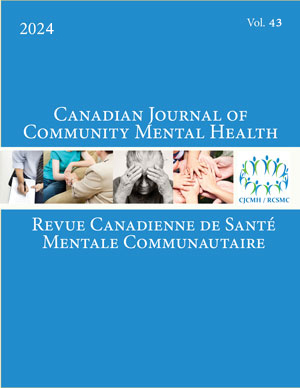Volume 33 • Number 2 • December 2014
Special Issue
Articles
OPEN ACCESS
Over 10 years ago, Quebec's statistical institute, the Institut de la Statistique du Québec, conducted its first population survey on family violence in the lives of children. Taken again 5 years later (2004), the survey showed a decrease in the use of corporal punishment of children. This paper presents the results of the third survey, which was conducted by telephone in 2012 with a representative sample of 4,029 maternal figures. More specifically, this paper presents the evolution of prevalence rates for corporal punishment and attitudes in favour of this practice as observed between the 3 surveys conducted in 1999, 2004, and 2012. The paper also presents the associations found between mothers’ attitudes and their reports of corporal punishment. The results show that attitudes and practices are closely associated and that corporal punishment has been in a constant and significant decrease since 1999, regardless of the children's age. Supported by a decrease in maternal attitudes in favour of this practice, the results are discussed in terms of changes in Quebec's social norms.
OPEN ACCESS
We examined self-reported use of spanking as a discipline strategy in a Canadian sample of mothers and fathers (N = 2,340) of children aged 2 to 12 years using data from the International Parenting Survey–Canada. Logistic regression was conducted to assess the association between reported use of spanking and child characteristics (age, gender, disability status, and behaviour problems), adult demographic characteristics (age at birth of child, marital status, education, employment, and income inadequacy), as well as parent attitudes toward spanking. Approximately one quarter of parents reported spanking their child. Child age, parent education, employment, and income inadequacy had significant associations with reported spanking. When controlling for child and parent demographic characteristics, parent reports of child behaviour and parent attitudes toward spanking also had strong relationships with reported spanking. Results are discussed in relation to previous findings and in terms of implications for parenting interventions.
OPEN ACCESS
The current study was designed to contribute to our growing understanding of childhood multiple victimization (i.e., exposure to more than one type of victimization), which has been found to be the reality among most victimized children. Caregivers of school-aged children (N = 213) completed an online and anonymous questionnaire that assessed the victimization experiences (lifetime) and psychosocial functioning of their child, as well as collecting information on a number of socio-demographic factors. Results provide support for the ubiquitous nature of childhood multiple victimization (86.9%), as well as the common cooccurrence of lifetime victimization experiences (Mexposure= 6.58). Findings highlight the important association between victimization exposure and psychosocial functioning (e.g., anxiety, depression, aggression, posttraumatic stress). The practical and theoretical implications for the prevention of childhood victimization are also discussed.
OPEN ACCESS
Despite the high prevalence of father-perpetrated maltreatment, relatively little empirical attention has been given to fathers who abuse and/or neglect their children. The current study explored the dynamics of harmful father-child interaction that may underlie fathers’ risk for perpetrating child maltreatment. Data derived from structured interviews of 121 maltreating fathers were used to discern differential patterns of abuse-related problems in parenting. Results show that a minimum of half the fathers showed problems in each of the following areas: emotional unavailability, unresponsiveness, and neglect; negative attributions and misattributions to the child (including hostility, denigration and rejection); developmentally inappropriate or inconsistent interactions (including exposure to domestic violence); and failure to recognize or acknowledge the child's individuality and psychological boundary. These interview-rated difficulties were consistent with expected patterns of demographic risk and self-reported psychosocial difficulties. When considered together in a cluster analysis, groups of abusive fathers emerged with low (37.0%), moderate (38.4%), and severe (24.6%) levels of problems across dimensions of harmful parent-child interactions. Results are discussed in terms of assessment and intervention needed to address father-perpetrated maltreatment.
OPEN ACCESS
Le marketing social (MS) constitue une stratégie intéressante en matière de prévention universelle. Il s'est avéré efficace pour réduire l'incidence de divers problèmes de santé publique comme le tabagisme ou la consommation d'aliments sucrés, contribuant à la prévention de plusieurs maladies. Le présent article s'adresse aux chercheurs, décideurs et praticiens et praticiennes qui oeuvrent dans le domaine de la prévention de la maltraitance envers les enfants, afin de les outiller pour élaborer des campagnes de MS efficaces dans ce domaine. Il examine le potentiel de cette approche pour réduire l'incidence des comportements parentaux coercitifs, violents, incohérents ou négligents, et rehausser le recours aux pratiques parentales positives. Les composantes d'une approche de marketing social sont présentées, ainsi que leur application à la prévention de la maltraitance. Les campagnes ayant été évaluées sont recensées et leur efficacité est présentée. L'article met en lumière le caractère prometteur du MS pour prévenir la maltraitance, surtout lorsqu'il intègre une approche communautaire et qu'il est lié à une offre de services directs aux parents.
OPEN ACCESS
Most physical violence against children is punitive in intent. The United Nations has called for the elimination of physical punishment of children and for the development of programs teaching nonviolent resolution of parent-child conflict. A focused effort is required to shift entrenched, intergenerationally transmitted, and culturally normalized belief systems about physical punishment. Positive Discipline in Everyday Parenting (PDEP) was developed to meet this need. Its short-term objectives are to: 1) reduce approval of physical punishment; 2) normalize parent-child conflict; and 3) strengthen parenting self-efficacy. PDEP was delivered by trained program facilitators to 321 parents living in 14 cities in Canada. Responses to pre and posttest questionnaires suggest that parents who completed postprogram measures were less likely to both approve of physical punishment and view typical parent-child conflict as misbehaviour on the part of the child, and also to have greater parenting self-efficacy. More than 90% believed more strongly that parents should not use physical punishment, and that PDEP would help them control their anger and build stronger relationships with their children. PDEP is a promising approach to the prevention of punitive violence against children.










